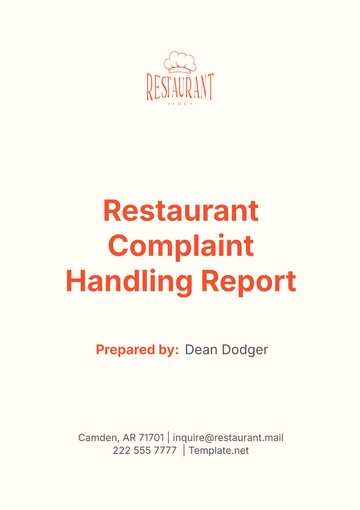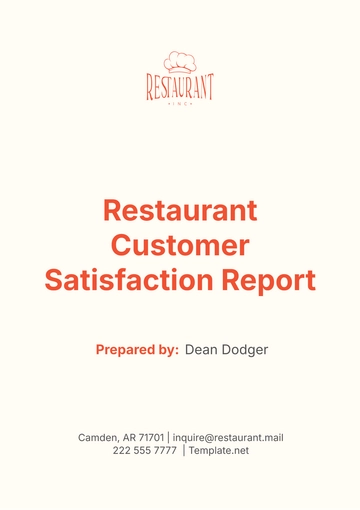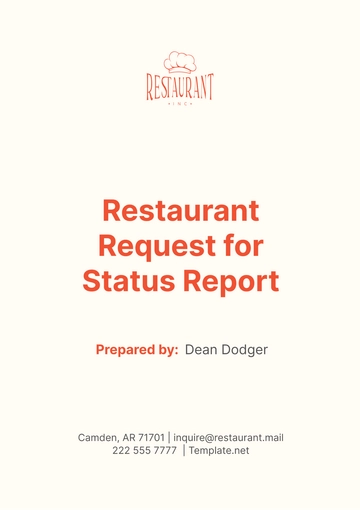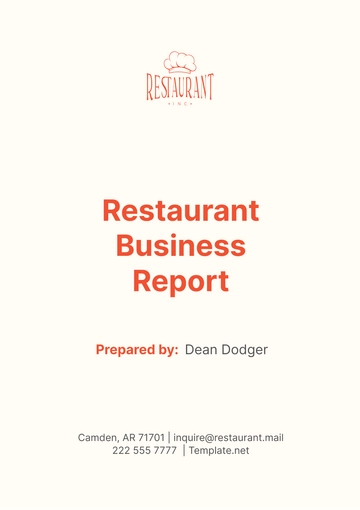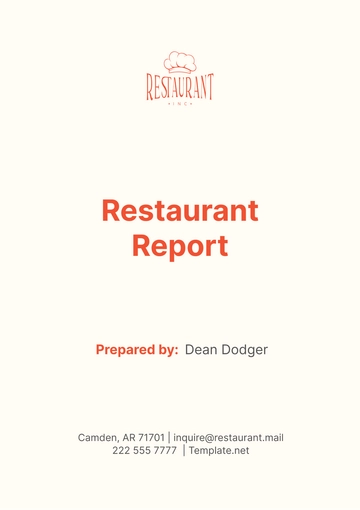Free Restaurant Complaint Handling Report

I. Executive Summary
The purpose of this report is to provide a comprehensive analysis of customer complaints received at [Your Company Name] over the past year, from January 1, 2050, to December 31, 2050. This analysis includes the types of complaints received, response times, and the effectiveness of the resolution strategies employed. The goal is to identify key areas for improvement to enhance customer satisfaction and service quality.
Effective complaint handling is crucial for maintaining the reputation of [Your Company Name]. By understanding the nature of complaints and addressing the root causes, we can improve our operational processes, customer interactions, and overall restaurant experience. This report serves as a foundational tool to drive continuous improvement initiatives within our establishment.
II. Overview of Complaints
In the reporting period from January 1, 2050, to December 31, 2050, a total of 350 complaints were recorded at [Your Company Name]. These complaints were meticulously categorized to facilitate a detailed analysis and to identify patterns and areas requiring improvement. The table below provides a comprehensive breakdown of the types of complaints received and their respective frequencies:
Type of Complaint | Number of Complaints | Percentage (%) |
|---|---|---|
Food Quality | 150 | 42.86 |
Service Quality | 120 | 34.29 |
Cleanliness | 50 | 14.29 |
Other | 30 | 8.57 |
Analysis of Complaint Types
Food Quality:
Frequency: Food quality complaints were the most prevalent, with 150 instances, accounting for 42.86% of the total complaints.
Nature of Complaints: These included issues such as food being undercooked or overcooked, incorrect orders, poor presentation, and food not meeting customer expectations in terms of taste and freshness.
Implications: The high frequency of food quality complaints indicates a significant area of concern that directly impacts customer satisfaction. Ensuring consistent food quality is crucial for retaining customers and maintaining a positive reputation.
Service Quality:
Frequency: Service quality complaints were the second most common, with 120 instances, representing 34.29% of the total complaints.
Nature of Complaints: Customers reported issues such as slow service, unprofessional behavior by staff, incorrect billing, and lack of attentiveness.
Implications: Service quality directly influences the dining experience. Prompt and courteous service is essential for creating a welcoming atmosphere and ensuring customer loyalty.
Cleanliness:
Frequency: Cleanliness complaints were reported 50 times, making up 14.29% of the total complaints.
Nature of Complaints: These complaints included dirty tables, unclean restrooms, and overall restaurant hygiene.
Implications: Cleanliness is a fundamental aspect of any restaurant's operation. Maintaining high standards of cleanliness is essential for customer health and satisfaction and can significantly impact repeat business.
Other:
Frequency: The 'Other' category accounted for 30 complaints, or 8.57% of the total.
Nature of Complaints: This category includes a variety of issues such as ambient noise levels, parking problems, and issues with online orders.
Implications: While less frequent, these complaints still impact the overall customer experience and should be addressed to ensure a comprehensive improvement strategy.
The predominant type of complaint was related to Food Quality, highlighting a significant area that requires targeted improvement strategies. Addressing these issues through enhanced quality control measures, staff training, and consistent monitoring can help reduce the frequency of such complaints.
III. Response Time Analysis
Response time is a critical factor in effective complaint resolution. Prompt responses not only mitigate customer dissatisfaction but also demonstrate a commitment to addressing and resolving issues. During the reporting period, the average response time for addressing complaints was 24 hours. The table below provides a detailed breakdown of response times across different categories of complaints:
Type of Complaint | Average Response Time (Hours) |
|---|---|
Food Quality | 20 |
Service Quality | 25 |
Cleanliness | 15 |
Other | 35 |
Detailed Analysis of Response Times
Food Quality:
Average Response Time: The average response time for food quality complaints was 20 hours.
Analysis: This relatively prompt response indicates that food-related issues are prioritized, likely due to their direct impact on the dining experience. However, there is still room for improvement to ensure immediate corrective actions are taken.
Service Quality:
Average Response Time: Service quality complaints had an average response time of 25 hours.
Analysis: This response time is longer than ideal, suggesting a need for quicker intervention. Improving the speed of response in service-related issues can enhance customer satisfaction and demonstrate attentiveness.
Cleanliness:
Average Response Time: Cleanliness complaints were addressed within an average of 15 hours.
Analysis: This quicker response time reflects the importance placed on maintaining a clean environment. Timely responses in this category are crucial for preventing health hazards and maintaining a positive dining atmosphere.
Other:
Average Response Time: The 'Other' category had the longest average response time of 35 hours.
Analysis: The extended response time in this category suggests a potential lack of streamlined processes for addressing less frequent complaints. Developing specific protocols for these issues can help reduce response times.
The data indicates that complaints related to the 'Other' category had the longest average response time. This suggests a need for process improvement in handling these specific complaints. By streamlining procedures and ensuring that all types of complaints are given prompt attention, overall response times can be improved.
IV. Effectiveness of Resolution Strategies
The resolution strategies employed by [Your Company Name] have varied in their success rates. Analyzing the effectiveness of these strategies helps identify which approaches are most successful in resolving customer complaints and which areas need improvement. During the reporting period, the success rate of resolving complaints to customer satisfaction was 80%. This section examines the strategies used and their impact.
Effective Resolution Strategies
Personalized Apologies from Management:
Success Rate: 95%
Details: Personalized apologies from management were highly effective in addressing complaints. Customers appreciated the direct acknowledgment from senior staff, which made them feel valued and heard.
Implementation: This strategy involves management personally reaching out to the customer to apologize and discuss the issue in detail.
Compensation in the Form of Discounts and Complimentary Meals:
Success Rate: 85%
Details: Offering compensation such as discounts on future visits or complimentary meals has been successful in appeasing dissatisfied customers. This gesture shows that the restaurant values their patronage and is willing to make amends.
Implementation: Compensation is typically offered based on the severity of the complaint and the customer's history with the restaurant.
Immediate Corrective Measures:
Success Rate: 90%
Details: Taking immediate action to rectify issues, such as replacing an incorrect order or addressing service delays on the spot, has proven effective. Customers appreciate swift action and feel their concerns are taken seriously.
Implementation: Staff are trained to identify issues promptly and take necessary corrective measures without delay.
Areas for Improvement
Speed of Response:
Current Satisfaction Rate: 80%
Target Satisfaction Rate: 90%
Details: Although the current response time is relatively good, there is room for improvement. Faster responses can enhance customer satisfaction and demonstrate a commitment to excellent service.
Action Plan: Implementing a more efficient tracking system and ensuring all staff are trained in quick response protocols can help achieve this target.
Proactive Follow-Up After Complaint Resolution:
Current Satisfaction Rate: 70%
Target Satisfaction Rate: 85%
Details: Following up with customers after resolving their complaints can significantly improve satisfaction levels. It shows that the restaurant cares about their experience and values their feedback.
Action Plan: Establishing a follow-up protocol where management contacts the customer after a few days to ensure their satisfaction can help improve this area.
Staff Training on Customer Service and Issue Handling:
Current Satisfaction Rate: 75%
Target Satisfaction Rate: 90%
Details: Continuous training in customer service and issue resolution is crucial for maintaining high standards. Well-trained staff can handle complaints more effectively and ensure a positive customer experience.
Action Plan: Regular training sessions focusing on customer service skills, problem-solving, and effective communication can help enhance staff performance in handling complaints.
By focusing on these areas for improvement and leveraging the effective strategies already in place, [Your Company Name] can enhance its complaint resolution process, leading to higher customer satisfaction and loyalty.
V. Recommendations
Based on the findings of this report, the following recommendations are proposed to enhance the complaint handling process at [Your Company Name]:
Implement a more robust and proactive complaint tracking system: This will ensure timely responses and enable better monitoring of complaint resolution progress.
Conduct regular staff training sessions: Focus on customer service excellence and complaint resolution to empower employees with the skills needed to handle complaints effectively.
Establish a standard operating procedure (SOP) for addressing common types of complaints: This will streamline the resolution process and ensure consistency in handling complaints.
Increase management involvement in high-severity complaints: Direct involvement from management in resolving high-severity complaints will help ensure customer satisfaction and demonstrate a commitment to resolving issues.
Enhance proactive follow-up procedures: Implement a system for following up with customers after complaints have been resolved to ensure satisfaction and gather feedback for further improvement.
Leverage technology for better data analysis: Utilize advanced analytics to identify trends and patterns in complaints, which can inform strategic decisions and targeted improvements.
VI. Conclusion
This report has provided an in-depth analysis of the complaint handling process at [Your Company Name]. It highlights key areas requiring improvement and presents actionable recommendations to enhance the effectiveness of our complaint resolution strategies.
Moving forward, it is essential to continuously monitor and analyze complaint data to ensure sustained improvements and maintain the high standard of service that [Your Company Name] is known for. By implementing the recommended strategies, we aim to significantly improve customer satisfaction and foster a more positive dining experience for all our guests.
This report is prepared by: [YOUR NAME]
This report is made under the company, [YOUR COMPANY NAME]
Restaurant Templates @ Template.net
- 100% Customizable, free editor
- Access 1 Million+ Templates, photo’s & graphics
- Download or share as a template
- Click and replace photos, graphics, text, backgrounds
- Resize, crop, AI write & more
- Access advanced editor
Uncover the ultimate tool for addressing customer concerns with ease: Template.net's Restaurant Complaint Handling Report Template. Designed to simplify the resolution process, this template empowers you to manage complaints effectively. Harness the power of our AI editor tool to tailor this template to your restaurant's specific requirements. Elevate customer satisfaction levels effortlessly with Template.net.
You may also like
- Sales Report
- Daily Report
- Project Report
- Business Report
- Weekly Report
- Incident Report
- Annual Report
- Report Layout
- Report Design
- Progress Report
- Marketing Report
- Company Report
- Monthly Report
- Audit Report
- Status Report
- School Report
- Reports Hr
- Management Report
- Project Status Report
- Handover Report
- Health And Safety Report
- Restaurant Report
- Construction Report
- Research Report
- Evaluation Report
- Investigation Report
- Employee Report
- Advertising Report
- Weekly Status Report
- Project Management Report
- Finance Report
- Service Report
- Technical Report
- Meeting Report
- Quarterly Report
- Inspection Report
- Medical Report
- Test Report
- Summary Report
- Inventory Report
- Valuation Report
- Operations Report
- Payroll Report
- Training Report
- Job Report
- Case Report
- Performance Report
- Board Report
- Internal Audit Report
- Student Report
- Monthly Management Report
- Small Business Report
- Accident Report
- Call Center Report
- Activity Report
- IT and Software Report
- Internship Report
- Visit Report
- Product Report
- Book Report
- Property Report
- Recruitment Report
- University Report
- Event Report
- SEO Report
- Conference Report
- Narrative Report
- Nursing Home Report
- Preschool Report
- Call Report
- Customer Report
- Employee Incident Report
- Accomplishment Report
- Social Media Report
- Work From Home Report
- Security Report
- Damage Report
- Quality Report
- Internal Report
- Nurse Report
- Real Estate Report
- Hotel Report
- Equipment Report
- Credit Report
- Field Report
- Non Profit Report
- Maintenance Report
- News Report
- Survey Report
- Executive Report
- Law Firm Report
- Advertising Agency Report
- Interior Design Report
- Travel Agency Report
- Stock Report
- Salon Report
- Bug Report
- Workplace Report
- Action Report
- Investor Report
- Cleaning Services Report
- Consulting Report
- Freelancer Report
- Site Visit Report
- Trip Report
- Classroom Observation Report
- Vehicle Report
- Final Report
- Software Report









